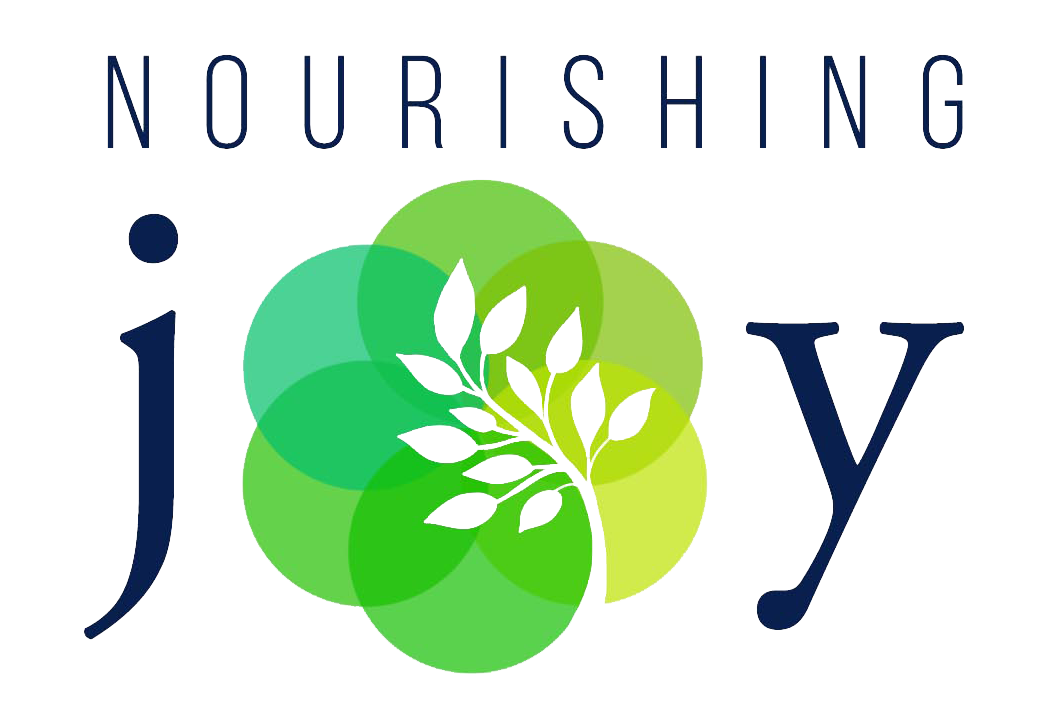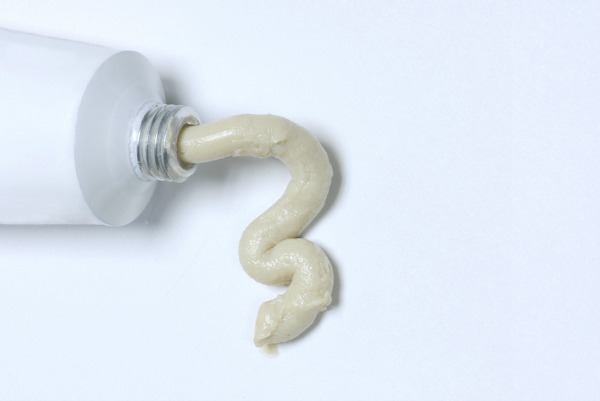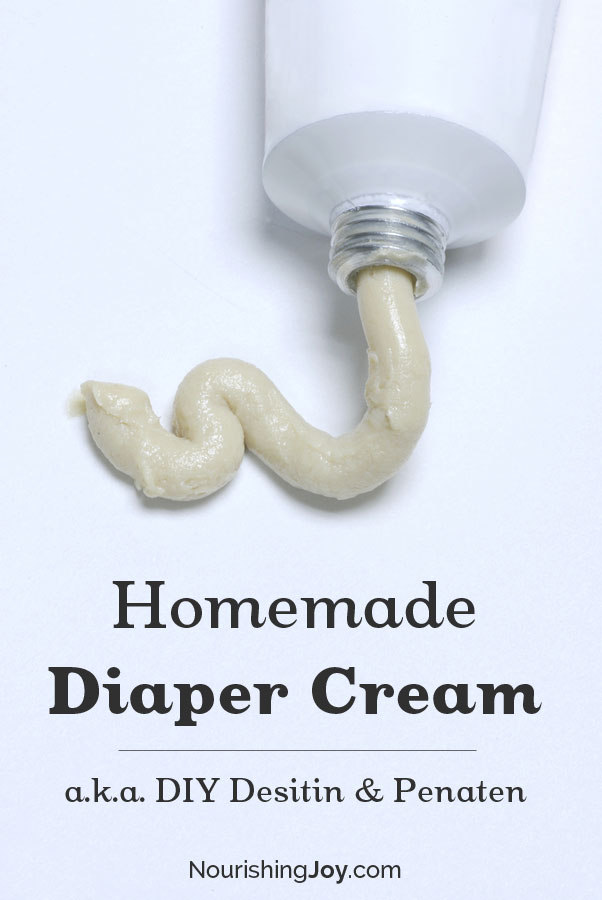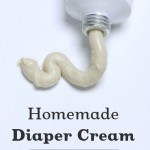Non-Toxic, Homemade Diaper Cream
This post may contain affiliate links, including those from Amazon.com, which means we earn a small commission off your purchases. And here's the thing: We only mention services and products that we think are truly worth your attention, whether they're free, paid, or otherwise. This site relies on YOUR trust, so if we don't stand behind a product 110%, it's not mentioned. Period.
As usual, as part of living a natural, non-toxic life, I've gotten used to flipping over the boxes and tubes my family's personal care products come in, just to see what we're actually smearing on our skin and rubbing in our hair.
Diaper cream is no exception.
Did you know the most popular brands of commercial diaper creams include petroleum-based endocrine disruptors, including BHA, petrolatum, and methylparabens? To their credit, however, at least one brand also uses lanolin, cod liver oil, and zinc oxide!
Using that brand as a baseline, here's the recipe for homemade diaper cream that I've settled on for our family (even though I've certainly raved about using just plain coconut oil in the past).
Please note that like any homemade cream or lotion based on oils and butters, this homemade diaper cream changes texture according to temperature, so in summertime (or in any warm climate) you may want to add more cocoa butter or less beeswax, and in winter (or in a cold climate) you may want to reduce the cocoa butter or increase the beeswax.
But, take heart, I didn't mean to make it sound difficult with that last paragraph!
I've played around with this recipe a lot and I've chosen these ratios because they tend to be the most stable at each part of the year in our climate and at most require a couple of seconds of warming either in my hand or on my son's bum to reach the ideal smooth texture.
A WORD TO THE WISE – if you live in a cool climate, don't try to put this diaper cream in a tube.
At some point it will inevitably solidify more than can be comfortably squeezed out and you will be left doing the angry monkey dance on top of the tube while your sore-bummed baby wails in not-so-sweet anticipation. The above photo may look promising, but – trust me – it ain't worth the trouble. This homemade diaper cream works best in a scoopable container with a lid.
Play around with works for you – the beauty of this recipe is that if you're not happy with it, you can just remelt it gently, add your new ingredients, and rewhip it!
Non-Toxic, Homemade Diaper Cream
Equipment
- electric mixer - either a stand mixer or a hand-held mixer
- tubes or containers to hold the finished diaper cream
Ingredients
- 20 g grated beeswax, about 2 tablespoons beeswax pastilles
- 120 g coconut oil, about a generous 1/2 cup
- 20 g cocoa butter, about 1/4 cup grated
- 1 teaspoon cod liver oil OR olive oil
- 1 teaspoon lanolin, optional
- 2 tablespoons zinc oxide
- 3 tablespoons bentonite clay
Instructions
- Place the bowl of an electric mixer or another mixing bowl in the freezer to chill. Meanwhile, gently melt the beeswax over very low heat.
- When the beeswax is nearly melted, add the coconut oil, cocoa butter, cod liver oil, and lanolin. Continue to heat gently until everything is liquid.
- Pour the mixture into the chilled bowl and add the zinc oxide and bentonite clay. Stir to incorporate the powders, then return to the freezer for 5-10 minutes.
- After chilling, whip the mixture with the whisk attachment of the electric mixer or using a handheld mixer for 5-10 minutes on medium-high speed until stiff peaks form. If the oils don't seem to be firming up, return to the freezer for another five minutes or so, then continue whipping.
- When the mixture is the texture of a firm, thick lotion, scoop into a storage container and keep near your change table. Mixture will last 3-6 months.
Notes
The Ingredients
Beeswax provides a stability for the diaper cream through any temperature and provides a moisture barrier for the skin. Raw beeswax is also known for its antimicrobial and antibacterial properties.
Coconut Oil is rich in antioxidants and bursting with natural microbial and antibacterial fatty-acids, and it’s loaded with Vitamin E, which hastens the recovery of the skin in traumas such as burns, cuts, and other wounds (in this case, diaper rash).
Cocoa Butter also provides a bit of stability for the diaper cream through various temperatures and adds a rich, thick, creamy consistency. It provides a bit of soothing for the skin and encourages healing.
Cod Liver Oil is rich in vitamins A and D, a skin protectant that forms a moisture barrier on skin. Cod liver oil also moisturizes the skin by blocking the loss of water through evaporation. The only downside is that it may leave a slight fishy scent and it is more prone to rancidity, so if you're not going to use the diaper cream within 1-2 months, opt for the olive oil.
Olive Oil is especially lovely in any skin care cream because its fatty acid content is basically the same as that found in the fatty tissue of the outer layer of skin. In this homemade diaper cream, olive oil softens and moisturizes the skin in a similar occlusive method as cod liver oil.
Lanolin is a natural moisture barrier derived from sheep's wool and works superbly in homemade lip balms and this homemade diaper cream to protect skin in periods of prolonged exposure to moisture. It's usually sold for breastfeeding moms as a nipple balm.
Zinc Oxide coats the skin and forms a serious barrier against wetness, which is why it's used so prevalently in commercial diaper creams. For the same waterproof reason, as well as the fact that its mineral content reflect UV rays, it's also the main ingredient in the most hard-hitting sunscreens, like the kind lifeguards wear.
Bentonite Clay helps draw toxins and excessive moisture out of the skin. This is especially helpful for an already existent diaper rash or for babies who have lots of creases and folds where moisture can collect.







Ah! I love your baseline brand! It was the only thing that was guaranteed to help my boys, but oh my, it is the devil when it gets into fabric and carpeting! Definitely not cloth diaper friendly. Do you think your recipe would be safe on cloth?
I have this same question!
Definitely. I’ve used it exclusively with cloth for nearly a year and I’ve never had a stain or “stickiness” I couldn’t get out.
That said, here are two tips:
1. If you’re concerned about keeping your diapers unstained or about wanting to honor your diapers’ warranty – or even if you just know you’re going to use the cream liberally – use a fleece liner in your diaper. That way the diaper cream will get on the fleece rather than the diaper and you don’t have to worry about it. (And pretty much everything releases off of fleece more easily than cotton/hemp/bamboo/PUL/microfiber…)
2. If this cream does get on fabric or the carpet or some other undesirable place, just deal with it as you would any other oil. Rub it with an ice cube to make it solid, then scrape as much as possible off. Then place another piece of fabric over it to blot it and warm it enough to make the oil melt. Continue to blot as much oil as you can, then if there’s still residue, cover the spot with an inch of salt for a day or two and let the salt draw up the remaining oil. Vacuum up the salt or pour it off, then rub the spot with dish soap and launder it as normal.
Ok, NOW I’m excited! I’m not worried about warranties, as I’m a covers and prefolds/flats kinda girl. As long as it doesn’t cause repelling issues, I am on board!
Also, thanks for the tips on getting cream out of carpet/fabric. My youngest went through a Desitin-eating stage, (zinc deficiency? 😀 ) and I still have white blotches on my carpet and SO many ruined clothes! Even my old standby, original Dawn, didn’t budge all that oil. I will be sure to give your tips a try!
Sharing on FB right now. Brilliant!
Would shea butter work instead of cocoa butter? I have that on hand…
It might work in a pinch, but the final product will be much softer and more “melty,” since cocoa butter is a more brittle butter. It would do wonders for your baby’s skin though! 🙂
What would adding an essential oil like lavender or tea tree do? My LO suffers from chronic diaper rash and we use just dry bentonite right now, but I was lookign to experiment. Would EO’s add anything or just be wasted (or contradict the properties of the zinc or bentonite)?
Yes, I think essential oils could be lovely in this application. They certainly wouldn’t interfere with any of the other ingredients! I’m not knowledgeable about the healing properties of various essential oils, though, so perhaps ask around for which oils could help a rash best. I’ve applied both tea tree and lavender to rashes with good results, but again, that was just my personal experience and I’m not qualified to give a dependable recommendation. 🙂
Any herbalists care to chime in?
Thanks! I am just about to place an amazon order for my ingredients to make this! I too have used lavender and tea tree with organic CO, but they just weren’t strong enough to combat my LO’s several months of rash (it took the raw out but never healed it entirely). Right now I am using straight powdered Bentonite Clay, which works to heal but doesn’t provide the barrier so when various cargivers forget to sprinkle the powder, the rash comes right back. Talk about frustrating–we have been dealing with this for over 6 months! So excited to try your cream since it offers the best of healing and barrier properties!
I SO hope it works for you!!! My son had open, weeping sores for months due to an undiagnosed food sensitivity and in many ways that’s why I developed this particular recipe. It didn’t always get rid of the rash (sometimes it did, but not always), but it always brought relief, so that alone was a welcome side effect. I hope it’s the same for you. {hugs}
First, in response to Siusan’s question, lavender is the best oil to use for diaper rash. I have a strong oil (Doterra brand) and use 1-2 drops per tablespoon of coconut oil. However, you can add up to 1 drop of lavender oil per teaspoon of coconut oil. Tea Tree oil (aka melaleuca) is a powerful anti-fungal oil. However, my medicinal manual does not recommend it for diaper rash. I do use tea tree topically for other fungal infections. When I work outdoors at my job all day in the summer and get a rash LIKE diaper rash but occurring anywhere that my clothing rubs the skin, I use a blend of 1-2 drops each Lavender & Melaleuca per tablespoon of coconut oil. If your child is not very sensitive to these oils (one guy in my house gets irritated easily by tea tree oil), I imagine that using tea tree would be fine, but not always necessary.
Second, for Kresha, I’d like to make this and upgrade from just using coconut oil as I have done till now. However, I haven’t the slightest clue as to where to buy almost all the ingredients! Where would you recommend buying raw beeswax, cocoa butter, cod liver oil, lanolin, zinc oxide, and bentonite clay?
Thanks!
Carol,
Thanks for the great tips!
As for sourcing ingredients, all of those ingredients should be easily found at a health food store, natural health center, or even a soapmaking supply shop. I’ll update the post as well with my favorite online sources for those ingredients, since I know that not everyone has access to those shops locally.
Thanks again!
Hello, i want to make sure i understand well. You recommend cocoa butter better then shea butter for a diaper cream? Can you please explain better why? Thank you!
Cocoa butter is a more brittle oil than shea butter, so when the mixture cools it’s keeps it firmer and more spreadable, rather than melting all over your hands (and your baby’s bum) as you spread it over the skin.
I hope that helps!
Hi, I have made this but find that the clay makes it feel gritty, is this right?
It just depends on how fine your clay is. If your clay is powdery, it shouldn’t be gritty (just like the fineness of cocoa powder can determine how silky a buttercream is), but if you have a coarser clay, then it might be slightly gritty. If you want to make sure you have a silky-smooth diaper cream, perhaps use an already hydrated clay (like Redmond Clay’s First Aid clay, whatever they call it).
I hope that helps!
I believe you misspoke when you said in warm weather it should have more cocoa butter and less beeswax, and then in cold weather less cocoa butter and more beeswax. You definately don’t want more of something greasy (cocoa butter) in warm weather, and you don’t want more of something that really sets up (beeswax) in cold weather.
Coul you use this on Tattoos Maybe
Hmmm… Interesting thought! I’ve never tried it, but I suppose it *would* work well for tattos. Please let us know if you try it. 🙂